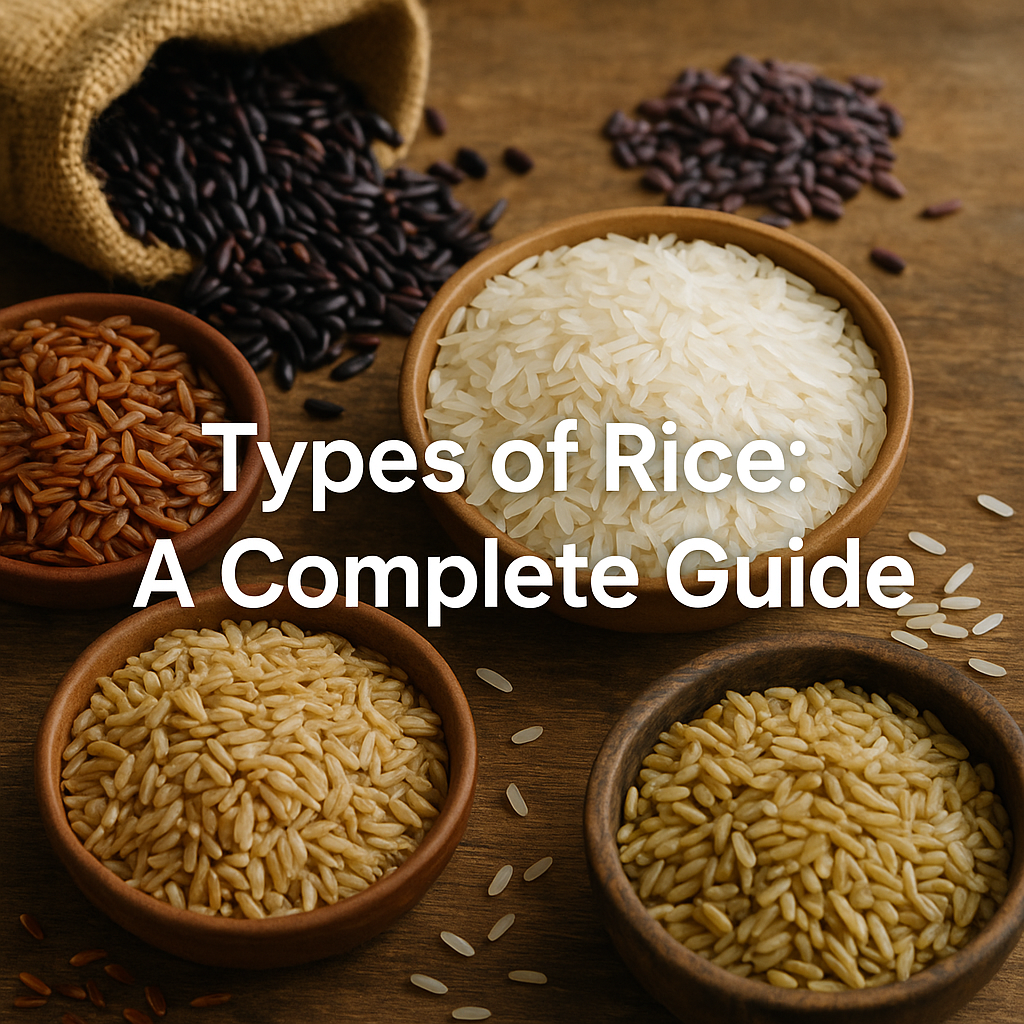Types of Rice: A Complete Guide
Rice is one of the oldest and most important grains cultivated by humankind. It’s eaten all over the world, but few people realize how diverse rice truly is—not only in color and shape, but also in flavor, aroma, cooking methods, and nutritional value. In this article, we’ll explore the main types of rice, their classification, origins, and culinary uses.
1. Rice Classification
Rice can be classified by grain size, processing method, and color.
1.1 By Grain Size
- Long-grain rice – Slender and long (over 6 mm), remains separate when cooked.
- Examples: Basmati (India, Pakistan), Jasmine (Thailand)
- Medium-grain rice – Shorter (5–6 mm), wider, slightly sticky.
- Examples: Arborio (Italy), Devzira (Uzbekistan)
- Short-grain rice – Round and less than 5 mm, very sticky when cooked.
- Examples: Japanese sushi rice, sticky rice
1.2 By Processing Type
- Polished (white) rice – Outer layer removed, quick to cook but loses some nutrients.
- Unpolished (brown) rice – Retains the bran layer, richer in fiber, takes longer to cook.
- Parboiled rice – Steamed before milling, preserves more nutrients, doesn’t overcook easily.
- Fermented rice – Includes black and red rice; often used in traditional medicine.
1.3 By Color
- White – The most common type.
- Brown – Richer in fiber, considered healthier.
- Black – High in antioxidants, with a nutty flavor.
- Red – Contains iron, widely used in Asian dishes.
- Purple, pink, golden – Rare, with unique nutritional properties.
2. Popular Types of Rice
2.1 Long-Grain Rice
✔ Basmati (India, Pakistan) – Aromatic, fluffy, perfect for pilafs and side dishes.
✔ Jasmine (Thailand) – Soft, slightly sticky, floral aroma, ideal for Asian dishes.
✔ U.S. Long-Grain – Neutral flavor, versatile as a side dish.
2.2 Medium-Grain Rice
✔ Arborio (Italy) – High in starch, creates creamy risotto.
✔ Carnaroli (Italy) – Similar to Arborio but firmer.
✔ Devzira (Uzbekistan) – Reddish-brown, perfect for traditional pilaf.
2.3 Short-Grain Rice
✔ Japanese (Sushi-mai) – Very sticky, ideal for sushi.
✔ Spanish Bomba – Absorbs water well, perfect for paella.
✔ Krasnodar Rice (Russia) – Soft, used in porridges and soups.
3. Rice by Country of Origin
- India, Pakistan – Basmati, aromatic long-grain varieties
- Thailand, Vietnam – Jasmine and sticky rice
- Italy – Arborio, Carnaroli for risotto
- Japan – Round rice, red and black rice
- China – Parboiled, black, jasmine rice
- USA – Long-grain and wild rice varieties
4. Culinary Uses of Rice
- Pilaf – Basmati, Devzira
- Risotto – Arborio, Carnaroli
- Sushi – Japanese short-grain rice
- Paella – Spanish Bomba
- Porridge – Krasnodar and brown rice
- Side dishes – Jasmine, long-grain white rice
5. Modern Research on Rice Benefits
✔ Black and red rice – Rich in antioxidants, support anti-aging.
✔ Brown rice – High in fiber, may reduce diabetes risk.
✔ Parboiled rice – Retains B vitamins better than white rice.
✔ Basmati – Has a low glycemic index, suitable for diabetics.
6. Interesting Facts
💡 Black rice was once called “forbidden rice” in China, reserved for emperors.
💡 Red rice is believed to be an aphrodisiac in Madagascar.
💡 Devzira rice expands 4x in size during cooking.
💡 In Japan, pink rice is served at weddings as a symbol of happiness.
Conclusion
Rice is incredibly diverse. Depending on the dish, your health goals, and personal preferences, there’s a perfect type of rice for everyone. Don’t hesitate to experiment—discover new varieties and enjoy the rich world of rice on your plate!




